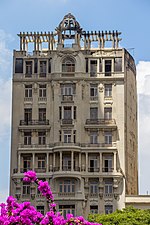Banco do Brasil Cultural Center (São Paulo)

The Banco do Brasil Cultural Center (Portuguese: Centro Cultural Banco do Brasil) in São Paulo, also known as CCBB São Paulo, opened on April 21, 2001. It is located in Álvares Penteado Street, in the historic center of São Paulo, and can be accessed by metro from São Bento Station. Currently, the streets around the building are pedestrian-only.In 1923, Banco do Brasil bought the old building, built in 1901, and hired Hippolyto Gustavo Pujol Junior, an engineer-architect, to convert it into a five-storey bank branch, which operated from 1927 until 1996. It was the bank's first building in São Paulo. Elements of the original architecture were restored to preserve the features that made the building one of the most significant examples in the city.The headquarters covers 4,183 square meters and includes exhibition halls, a cinema, a theater, an auditorium, a restaurant, a shop and a coffee shop. According to The Art Newspaper's ranking, it is the fifth most visited cultural institution in the country and 69th in the world.
Excerpt from the Wikipedia article Banco do Brasil Cultural Center (São Paulo) (License: CC BY-SA 3.0, Authors, Images).Banco do Brasil Cultural Center (São Paulo)
Rua Álvares Penteado, São Paulo Glicério
Geographical coordinates (GPS) Address External links Nearby Places Show on map
Geographical coordinates (GPS)
| Latitude | Longitude |
|---|---|
| N -23.5475 ° | E -46.634611111111 ° |
Address
Centro Cultural Banco do Brasil São Paulo (Centro Cultural Banco do Brasil)
Rua Álvares Penteado 112
01012-000 São Paulo, Glicério
São Paulo, Brazil
Open on Google Maps











